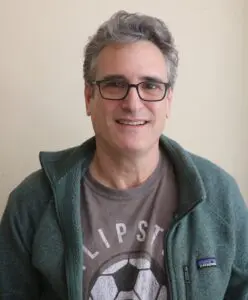Michael Robinson, a Cold Spring resident who owns Urban Myth Construction, recently received a Buildings of Excellence Award from New York State for his plan to construct an energy-efficient, low-income apartment building in Newburgh.
 What are the particulars of the building?
What are the particulars of the building?
It will be a three-floor, six-unit building, wood-frame construction, built on what is now a vacant lot. Each apartment will be 800 square feet, with two bedrooms. Most of the construction will be done off-site, then moved to the lot. I hope to complete the project in just over a year.
How will you make it energy-efficient?
Unlike with some tall, skinny buildings, there’s enough room for rooftop solar panels. It will be all-electric, but residents won’t have electric bills, which is ideal for lower-income residents. It will be well-insulated, have high-quality windows and be airtight, but with fresh, filtered air coming in that’s constantly recycled through an energy recovery ventilation system. It will meet net-zero standards known as Phius certification, probably producing a little more electricity than it consumes.
There are hurdles to get to this standard of efficiency in small buildings. Developers often don’t do this kind of project because of the mechanicals. I’m working with a guy as a pilot project. He’s developing a system similar to what’s been used in Europe for a decade. It takes the heating, cooling, hot water, energy and air exchange and bundles and intertwines the technologies. The project will show that is more attainable than people think, and that’s why NYSERDA [the New York State Energy Research and Development Authority] endorsed it.
The project is known as North Miller Passive 2. How does that compare with Phase 1, which was a 2019 award winner?
About six years ago, I bought two adjacent properties from the City of Newburgh for $19,000. In Phase 1, the first Phius-certified house in Newburgh, I renovated a brownstone that had been abandoned for more than 10 years. It had raccoons living in it and human feces everywhere. Workers walked out on me, saying I couldn’t pay them enough to work in that environment. So I did much of the work myself, making it less costly.
Phase 2 will be stick [wood] construction but we’ll use a bit of brick so it blends in with the local environment. The building will look almost identical to Phase 1 but slightly larger. Phase 2 mechanics are more efficient; most can be installed by unlicensed labor, so that’s less expensive. And solar efficiency has improved about 20 percent since 2019.
What interested you first, net-zero or low-income?
Both. Dar Williams and I remain great friends but before we divorced our counselor asked me what I wanted to do with my life. I had built certified passive projects; I knew people in Brooklyn who were renovating brownstones to Phius standards at the same cost as normal construction. Driving in Newburgh one day, I saw these dilapidated houses people were living in. I thought, “This is a housing crisis; this is how I can lend my talents to the real world.”
As a builder, how do you benefit?
Frankly, a lot of people think I’m frigging nuts! Phase 1 spins off a little income, but I’m not going to retire on it. I don’t have $1.8 million to build Phase 2. NYSERDA is giving me $124,000 with the award. It’s their way of saying the project will gain attention, that it’s reproduceable and could proliferate. I’m looking for other revenue, including federal programs. I’m not doing this completely out of the kindness of my heart — I’m not St. Francis! I will hopefully have a building someday and be the landlord. And my kids will have a building.


Michael is risking his time and money to help make a local city a better place to live and, at the same time advancing the real-world possibilities of more efficient and healthy building environment solutions. He deserves a lot of credit.